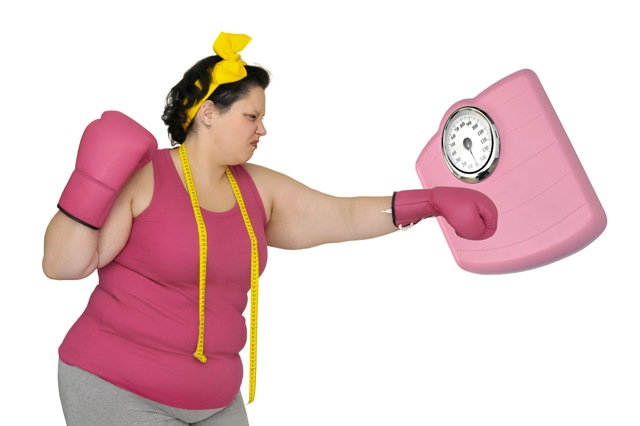Do you have love handles? Muffin top? Spare tire? Menopot? Jelly belly? The list of disparaging terms women use for the belly fat from menopause goes on and on. As they stare into the mirror at their once-svelte bodies and try to zip up a favorite pair of pants, they wonder what is going on. “I’ve got a closet full of clothes that don’t fit,” one of my patients told me, “and I don’t get it! I go to the gym four times a week and eat a pretty healthy diet. I cut way back on carbs like pasta and bread and treat myself to a glass of wine just twice a week, but nothing I do makes any difference. If I lose weight, it’s from my face, neck, and arms, but not from my waist and belly.” This one of the many stories I cover in my new book The Estrogen Fix, due out from Rodale on September 19.

Belly fat is not just a cosmetic issue, limited to the amount of fat we can pinch between our fingers; it also has a more sinister medical significance. Another accumulation of fat surrounds our internal organs beneath the fascia or canvas covering of our belly: visceral fat. It really should be called “vicious” fat because it contributes to a host of diseases that increase the risk of heart disease, high blood pressure, stroke, joint disease, and type 2 diabetes, though for 16 percent of women, their metabolism stays healthy in spite of their increased weight, probably because of genetic factors. Studies show that being overweight or obese isn’t only a medical issue; it also affects quality of life and self-esteem.
Body Mass Index (BMI)
Body mass index (BMI) is a person’s weight in kilograms divided by the square of height in meters. A high BMI can be an indicator of high body fat. BMI is a screening tool, but it does not diagnose fatness or health of an individual.
To calculate your BMI, use the BMI calculator at: http://1.usa.gov/1dSzT3p.
- A BMI less than 18.5 falls within the underweight range.
- A BMI 18.5 to 24.9 falls within the normal or healthy weight range.
- A BMI 25.0 to 29.9 falls within the overweight range.
- A BMI 30.0 or higher falls within the obese range.
I have a personal appreciation for this issue. When I was helping my then 91-year-old mother move from the house I grew up in to a smaller condominium, I found a box of old newspapers. In that box were the headlines “Pearl Harbor Attacked” and “President Kennedy Assassinated.” But it was a different front-page headline that caught my attention; it read, “Mighty Might: The Fattest Kid in the County.” The photo was taken many years ago in December in front of a large Christmas window display at Sears filled with Santa and his reindeer and piles of fake snow. In front of him stood a fat two-and-a-half-year-old boy in pleated pants looking like Santa’s mini. The fat little boy in the picture was me. I learned growing up that being large does not expand how good you feel or how good you feel about yourself. Feeling bad about myself and being incessantly teased and unable to keep up with the other kids motivated me to learn to watch what I eat, get enough exercise, and control my weight as an adult. While being fat certainly isn’t healthy, I can tell you from personal experience, it’s also no fun.
According to Business Insider, the “average” American woman now wears a size 14 with “plus-sizes, often classified as sizes 14 to 34, needed for 67 percent of the population.” If this sounds like you, you are definitely not alone. For many women, this transition to clothes that are several sizes larger begins around menopause. Why is that? Does estrogen influence midlife weight gain in women?

Is Midlife Weight Gain in Women Due to Menopause or Aging?
It is true that the body’s metabolism slows down a little each decade, resulting in weight gain of about 1 pound per year due to age. But is your jelly belly a function of weight or weight distribution? Is it just weight gain or has a huge rearrangement of your body’s fat seemed to implant a bull’s-eye on your belly? And what role do your hormones play?
The transition from your reproductive years to menopause begins when your periods become irregular and ends with your last period. Evidence is mounting that this transition is marked by “unfavorable changes in body composition, abdominal fat deposition and general health outcomes.”
Your ethnic group and level of activity should be considered when it comes to obesity and fat distribution. In a study of 16,000 women, telephone interviews were done with US Caucasian, African American, Hispanic, Chinese, and Japanese women. The study concluded that the mean weight of the entire group of women over the 3 years of the study did not differ as the women progressed from premenopause to postmenopause after adjusting for age and other variables. Interestingly, the mean weight of the Caucasian women was significantly greater than the weight of the Chinese women by 2.1 kilograms (about 5 pounds), and the study design led the researchers to determine this increased weight was not due to menopause.
In another study, researchers randomly assigned about 17,000 postmenopausal women who were not using hormone therapy to either a control group that ate whatever it wanted or a different group with a healthier diet that included among other things increased fruits, vegetables, and whole grains. After a year, women in the group who ate a healthy diet had fewer hot flashes and were three times as likely to have lost weight. You can’t control your heritage. You can, however, control what you eat. And it does make a difference in your weight.

What Role Do Hormones Play in Menopause Weight Control?
Once the ovaries of mice are removed, studies have shown that they gained weight no matter what they were fed, because of a change in their metabolism.13 The mice burned fewer calories even though they ate the same diet, and their existing fat cells got larger from storing larger quantities of fat. They developed more belly fat and more inflammation in their bodies, and they became insulin resistant, meaning their pancreas had to produce more insulin to allow the same amount of glucose to enter their cells. Mice that had their ovaries removed also burned fewer calories with exercise and had less energy, so they were less active.14 When the mice had their ovaries removed and were given the estrogen 17 beta-estradiol, they had no weight gain, no larger fat cells, no increased belly fat or inflammation, and no insulin resistance. Some animal studies showed that when given estrogen, the mice became full on smaller portions of food.
What about belly fat, estrogen, and women? Abdominal obesity or belly fat is almost double that of general obesity. It’s present in 65.5 percent of American women aged 40 to 59 and 73.8 percent of women aged 60 or more. All this starts in perimenopause as estrogen levels begin to decline. The lower estrogen levels appear to cause and to increase the redistribution of fat, making a pear-shaped body into an apple-shaped one. A large number of studies show that postmenopausal women have greater amounts of intra-abdominal fat compared to premenopausal women. A study at the Mayo Clinic1 helps explain why. The researchers compared fat tissue in pre- and postmenopausal women of similar ages. They found that at the cellular level, the lower levels of estrogen in postmenopausal women caused more activity from two enzymes, adipocyte acyl-CoA synthetase and diacylglycerol acyltransferase, which synthesize and store fat. When estrogen levels were higher in premenopausal women, those enzymes were less active. This is all part of the estrogen fix and what I explain in great detail in my book The Estrogen Fix.
Another recent study drove home the point. A group of researchers at the University of Colorado gave a medication to premenopausal women to temporarily cause menopause. That way, menopausal changes in metabolism due to aging could be eliminated. Once the women were in menopause, the researchers compared the effects of giving half of the participants either estradiol or a placebo. The women who did not take estradiol developed more belly fat and lost bone mass in their spines and hips. There was no change in the women who received estradiol.
So increased fat production and storage is causing waist sizes to get larger, in the form of the “love handles” you can feel and the internal fat you cannot. That is where heart disease, high cholesterol, inflammation, and diabetes risks lie in ambush.
The visceral, or internal, belly fat is more than just an accumulation of jelly belly. Visceral fat is a hormone-making machine that produces unhealthy substances such as adipokines that contribute to insulin resistance, type 2 diabetes, changes in tissue metabolism, and metabolic syndrome.
Discover more about estrogen and staying fit and trim in menopause in my new book, The Estrogen Fix. Purchase it before September 19 and get 9 free bonus gifts as a thank you.
